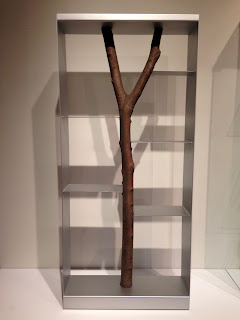BY: MAYA DONKERS
The Montreal Museum of Fine Arts is arguably one of the Canada’s premier institutions. With its seamlessly sweeping floor plan from one pavilion to another, the MMFA is not only easy to navigate (while taking in the aesthetic splendour), but its content is also unparalleled.
During a recent visit to the MMFA, I was surprised to find the majority of my time was spent in the Decorative Arts and Design Pavilion. I was previously unaware that the MMFA possessed such an important decorative art and design collection, spanning centuries, movements, and designers. As I wandered through the expansive galleries, there was one thing I did know for sure – I wanted it all in my [imaginary] apartment.
ENTRANCE HALLWAY
 |
| Ettore Sottsass. 1967 (example of 1986). Odalisca Totem. Photo Credit: Maya Donkers |
As soon as I discovered that Ettore Sottsass was once coined, "The godfather of Italian cool," I knew I had to include as much of his work as possible in my imaginary apartment. Sottsass was a pivotal figure of the late 20th century Italian design scene. Best known as the founder of the early 1980s Memphis Group, he was also the man who toyed with publishing a cook consisting of a picture of walls.
LIVING ROOM
 |
| Gruppo DAM, Studio Gruppo 14. 1976. Libro Chair. Photo Credit: Maya Donkers |
Note: This chair is unique both in its design and functionality. Each "page" of the chair, can be moved from one side to the other as a way to shift the position of the sitter.
Decorative art and design in Milan from the early 1970s to late 1980s drew inspiration from movements such as Art Deco, Pop Art, and included stylistic features from the 1950s Kitsch and Futuristic themes. The work of the Memphis Group and Gruppo DAM has recently transcended industries as these designs have served as inspiration for the Fall/Winter 2011-2012 Christian Dior Haute Couture collection, for the Winter 2015 Missoni collection. Even fashion designer Karl Lagerfeld has collected Memphis pieces for his [real-life] living room.
TV ROOM / REC ROOM
 |
| Andrea Branzi. 1991. Piccolo albero Bookcase. Photo Credit: Maya Donkers |
Andrea Branzi is an architect and designer also based in Milan. Since 1967, Branzi has worked in the fields of industrial and research design, architecture, urban planning, education, and cultural promotion. His artistic approach in trying to connect the industrial world to the "poetry of nature" is reflected in his works with trees. Branzi notes, "Trees, trunks and branches are part of our ancient culture but also of actual culture, because in the age of globalization, design searches to trace recognizable 'anthropological' platforms. The collection 'Tree' consists to place simple everyday objects, books and images next to the strange presence of branches and trunks, like in the reality of the world."
 |
| Pedro Friedeberg. 1961. Baphomet's Handtable and Handchair. Photo Credit: Maya Donkers |
Much of Pedro Friedeberg's work has an industrial quality that almost always has a touch of sarcasm and cynicism. He produced furniture that rejected the predominantly international style of architecture and design that was being taught in Mexico. Friedeberg created unusual compositions and designed furniture and 'useless' objects, admitting that his artistic activity was rooted in boredom. Although Friedeberg is best known as the man behind the Baphomet's Handtable and Handchair, he and Frida Kahlo were the only two Mexican artists recognized by Andre Breton as part of the Surrealist movement, making Friedeberg the last of the Mexican Surrealists.
 |
| Fernando Campana and Humberto Campana. 2008. Cake Stool. Photo Credit: Maya Donkers |
The Campana brothers are Brazilian designers who make furniture out of ordinary materials, as seen in their use of stuffed animals for Cake Stool. Although this work is new to the MMFA, it was the perfect final touch to my imaginary apartment, don't you agree?
THE REST OF THE APARTMENT
I would love to share a detailed room-by-room interior design of my imaginary apartment, but I leave it up to you to explore the decorative arts and add to my list. Comment below if you have any favourite furniture pieces that would make a welcome addition to what will become our virtual apartment!
Sources
Andrea Branzi Architetto. n.d. Weak and Widespread. Accessed March 13, 2016. http://www.andreabranzi.it/.
Design Museum. n.d. "Profile." Ettore Sottsass. Accessed March 13, 2016. http://designmuseum.org/designers/ettore-sottsass.
Edra. n.d. "Fernando and Humberto Campana." Designers. Accessed March 13, 2016. http://www.edra.com/en-us/profile/designers/fernando-and-humberto-campana.
Carpenters Workshop Gallery. n.d. "About the Artist." Andrea Branzi. Accessed March 13, 2016. http://carpentersworkshopgallery.com/en/Artists/Andrea-Branzi.
Memphis-Milano Design. n.d. Story. Accessed March 13, 2016. http://www.memphis-milano.org/.
Design Museum. n.d. "Profile." Ettore Sottsass. Accessed March 13, 2016. http://designmuseum.org/designers/ettore-sottsass.
Edra. n.d. "Fernando and Humberto Campana." Designers. Accessed March 13, 2016. http://www.edra.com/en-us/profile/designers/fernando-and-humberto-campana.
Carpenters Workshop Gallery. n.d. "About the Artist." Andrea Branzi. Accessed March 13, 2016. http://carpentersworkshopgallery.com/en/Artists/Andrea-Branzi.
Memphis-Milano Design. n.d. Story. Accessed March 13, 2016. http://www.memphis-milano.org/.
Montreal Museum of Fine Arts. n.d. Decorative Arts and Design. Accessed March 13, 2016. https://www.mbam.qc.ca/en/collections/decorative-arts-and-design/#toggle-id-1.
Montreal Museum of Fine Arts. n.d. Design in Italy from the Postwar Period to the Present [Label].
Montreal Museum of Fine Arts. n.d.
Pedro Friedeberg. 2013. Biography. http://www.pedrofriedeberg.com/?page_id=49.
Montreal Museum of Fine Arts. n.d. Design in Italy from the Postwar Period to the Present [Label].
Montreal Museum of Fine Arts. n.d.
Pedro Friedeberg. 2013. Biography. http://www.pedrofriedeberg.com/?page_id=49.



No comments:
Post a Comment
Note: only a member of this blog may post a comment.